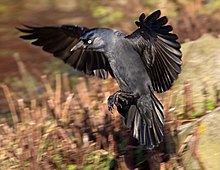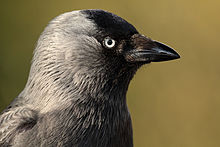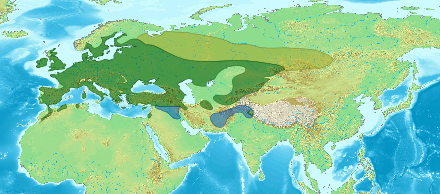Western jackdaw
![]()
This article is about the bird species Corvus monedula. For other meanings of the word, see Jackdaw (disambiguation).
The jackdaw (Corvus monedula) is a species of songbird in the corvid family (Corvidae). It is one of two species of the subgenus Jackdaws (Corvus subgen. Coloeus). Compared to the closely related species of ravens and crows (Corvus), it is a rather small representative of the corvids. It is characterized by black-grey plumage, a stout bill and light blue eyes. The jackdaw's range extends from the Atlas Mountains of North Africa through Europe to Lake Baikal. It prefers open habitats with trees, rocks or old buildings as habitat. The jackdaw's diet consists mainly of seeds and insects, but on occasion it will also eat carrion or human waste. Jackdaws usually live in larger groups and form lifelong monogamous pairs. They build their nests in holes and niches of all kinds, such as woodpecker cavities or niches in buildings. The female hatches four to six eggs, and the nestlings are subsequently fed by both parents.
The jackdaw was first described in 1758 in Linné's Systema Naturae. It is divided into four subspecies and is the sister species of the East Asian magpie jackdaw (Corvus dauuricus). The jackdaw is considered to be globally endangered, with populations probably in the tens of millions. In some regions of Europe, however, it is declining, mainly due to a lack of nesting sites.
Features
Physique and colouring
The jackdaw is a medium-sized raven with a body length of 33-39 cm. It appears stocky - especially in comparison with most ravens and crows - and has a stout, strong bill and relatively short legs. The jackdaw's tail is of medium length and slightly rounded compared to the genus, and its wings are rounded, weakly fingered, and fall slightly behind the tail when attached. Male jackdaws grow larger on average than females, although there is overlap in dimensional ranges: Males reach a wing length of 208-255 mm and a tail length of 122-138 mm. Their bill grows to 20.6-21.5 mm from nostrils to tip, and the male barrel measures 42.3-49.0 mm. The male weight is 174-300 g. With 205-250 mm wing length, 115-134 mm tail length, a 19.8-23.2 mm long bill and 41.2-46.5 mm barrel length, and a weight of 175-282 g, females attain only slightly smaller maximum measurements, but significantly smaller mean values.
The jackdaw shows some variation in plumage across its range and also within the postulated subspecies. However, all birds show the same basic pattern. The sexes are very similarly coloured and differ at most in a slightly lighter colouration of male birds at certain times of the year. The nasal bristles, forehead, forewing, eye area, cheeks and chin down to the throat are black in adult jackdaws. The black head crest shimmers metallic blue or purple. The posterior crest, back of the head, nape of the neck, and ear coverts contrast with the black crest by their light to slate gray coloration, but blend into black in the cheek, throat, and nape areas. On the sides of the neck and in the nape of the neck, some individuals develop a sometimes more, sometimes less distinct, silver-gray band that widens toward the breast and separates the plumage of the head from the body plumage. The jackdaw's back, like its wings and tail, is blackish gray to black. The wing feathers shimmer faintly greenish or bluish. The underside of the jackdaw's body - breast, flanks, belly, and abdomen - are slate gray and darker than the back of the head. From molt to molt, especially the gray areas of the plumage fade. In black feathers, usually only the edges fade, resulting in a scaly pattern on the back. The nasal bristles turn rusty brown with time. Old birds have a whitish-blue iris, which contrasts strikingly with the black facial plumage. Their bill is black, as are their legs.
Young birds differ in colour only in some details from adults. Their plumage colours are duller and show considerably less gloss than those of adults. The black parts of the plumage of adult birds appear more brownish or greyish in them, and the colour distinction of the head plate from the back of the head is less clear. The most obvious difference is the eye colour: after the juvenile moult, the iris colour of the birds changes from light blue to dark brown. Only after about one year it becomes lighter again from the outside, from the third year of life it is completely white-blue again.
Flight pattern and locomotion
On the ground, the jackdaw moves with a brisk gait. Due to its small size and shorter legs, it appears more hectic when running than larger species of its kind. Its head is always raised high and its tail is slightly angled up. Rarely, the jackdaw runs or hops over the ground, sometimes with the help of its wings. In rough terrain or in the branches it moves away hopping. Jackdaws are also able to cling to scarce protrusions or hollows in rock or walls on vertical walls, using their tail for support.
In flight, too, the jackdaw stands out for its liveliness and agility. It flies with rapid, quite jerky wing beats and reaches comparatively high speeds. At around 60 km/h, it is faster than ravens (Corvus corone) or rooks (Corvus frugilegus), but adjusts its speed in mixed flocks. The jackdaw's relatively light weight and more compact build also make it more agile than larger corvids, giving it an advantage at food sources. Thus, unlike heavier crows, it can walk on thin branches and land and take off again faster than them. The jackdaw uses updrafts for acrobatic flight manoeuvres or energy-saving soaring.
vocalizations
Jackdaws are birds that love to call and possess - probably due to their high degree of sociality - a very broad repertoire of sounds. Characteristic for the species are short, monosyllabic and metallic-snapping calls, which sound higher than the vocalizations of larger ravens or crows. Kja, kjä and tschack are the most frequently heard jackdaw calls and exist in many different variants.
The jackdaw has many situation-specific calls, most of which are choppy and high-pitched. In addition, it also makes long-drawn, croaking vocalizations, such as an errrr or ärrrr in a state of excitement. At mating time jackdaws sing with a subsong composed of a multitude of different calls, which have been freed from their actual context. By placing more emphasis on individual calls, a subsong can also express a particular mood. Imitation of ambient sounds or calls of other species is not known from jackdaws in the wild.

A jackdaw in flight

Jackdaw on approach. In flight, the species is faster and more agile than large crows, which often gives them an advantage at feeding sites.

Light feather tips on the neck - as in this individual - sometimes lead to thin, light lines on the sides of the neck of jackdaws. They can be very distinct, but also completely absent.

Head study of a jackdaw, taken in England. Birds of all populations have the same black-grey head pattern, but with varying saturation and contrast.
Distribution and migrations
Species range and distribution history
The range of the jackdaw includes almost the entire temperate Western Palearctic from Central Asia to North Africa. The breeding grounds cover an area of 15.6 million km², and the total species range is around 20.0 million km². The easternmost breeding areas are at Lake Baikal. From there they extend westwards along the 12°C July isotherm to the coast of the White Sea. Further west, the breeding areas extend to Finland, Sweden and Norway. Fennoscandian breeding occurrences largely omit the northern inland and Atlantic coast and are concentrated around the Baltic Sea, but the jackdaw is absent from the northern coast of the Bothnianwiek. South of Scandinavia, almost the whole of mainland Europe is colonised, the jackdaw being absent here - due to colder summer climates - only in the high mountains, the Bay of Biscay and the Portuguese west coast. The larger British Isles are populated extensively, only the Highlands and more remote island groups do not belong to the breeding areas. With the exception of the Balearic Islands and Corsica, the jackdaw is also a breeding bird on the large islands of the Mediterranean. In North Africa, occurrences are smaller and more disjunct than in Eurasia, mainly due to the climate. In Morocco, the jackdaw only occurs in two areas in the Atlas Mountains, which also extend into the lowlands east of Ouezzane. In Algeria, the breeding range includes the north-west coast and Constantine; earlier occurrences in Tunisia are extinct. Asia Minor is almost completely occupied by the jackdaw, with a smaller occurrence in northern Israel. East of this, breeding areas include Caucasia and northwestern Iran. Central Asia is colonized only along the outer regions and northwest to the Aral Sea. An isolated population exists in the eastern Elburs Mountains. The breeding range in the east includes the high mountains on the edge of the Tibetan Plateau to the Mongolian Highlands. In Kashmir, another small breeding population exists on the southwestern edge of the Himalayas.
The early and middle Pleistocene finds attributed to the jackdaw come mainly from southern and southeastern Europe and are restricted to regions with warm climates or warmer interglacials. Only towards the end of the Pleistocene are fossils also found in northern central Europe. Jon Fjeldså assumes that after the ice ages the jackdaw advanced north and west from heat islands along the Central and Black Seas and from Turkestan. Before humans reached the Balearic Islands, the jackdaw was also native there. Northern Europe, on the other hand, was colonized late; in what are now Denmark and Norway, the jackdaw probably did not become a breeding bird until around 1000 BC. In the 19th and 20th centuries, there were major expansions of the species range. Initially, the jackdaw advanced northwards along the Gulf of Bothnia, probably favoured by a warming of the local climate and increasing urbanisation of the species. In Tunisia, however, the existing breeding populations became extinct towards the end of the 19th century, and in Malta the jackdaw disappeared due to intensive hunting. In Siberia, the species was able to open up new regions until 1980 through the opening of the taiga forests. More recently, it has expanded its range northwards in the British Isles.
Hikes
Although jackdaws can be found throughout most of their range all year round, most populations move away from breeding areas in winter. However, because departing breeding populations are replaced by winter visitors, the migration is often unnoticeable. Migration routes to wintering grounds are mostly westward along the Atlantic coast and adjacent seas, and southwestward in continental Eurasia. Northern breeding populations migrate farther than southern ones: Central Asian Russian occurrences travel up to 700 km, while Eastern European ones travel just over 300 km, while Swiss birds often travel only a few kilometres. The number of resident birds also varies from north-east to south-west. For example, about 70% of Polish, but only 23% of Belgian Jackdaws migrate away from the breeding grounds in winter. In North Africa, all breeding populations consist of resident birds, but they are reinforced in winter by smaller numbers of birds migrating across the Mediterranean. Turkish birds use Mesopotamia as a winter roost, and jackdaws from Central Asia are found in Pakistan and Afghanistan in winter. In winter, resident birds also leave the higher altitudes and move to the lowlands. Many populations then concentrate on human settlements, where sufficient roosting sites and food sources are available. In parts of northern Europe, jackdaws do not move from towns at all, if circumstances are favourable enough. Migration starts in September in the north, in the south it can be delayed until November. The retreat begins early in the year in February and March and is usually completed by the end of March.

Distribution range of the jackdaw. Green: breeding and winter roosts; yellow: summer bird only; blue: winter visitor only
Questions and Answers
Q: What is a jackdaw?
A: A jackdaw is a large bird that belongs to the crow family Corvidae.
Q: What is the color of a jackdaw?
A: A jackdaw is black with the back of the head grey.
Q: Where is the jackdaw common?
A: The jackdaw is common over the whole of Europe and much of Asia.
Q: Does the jackdaw migrate in winter?
A: Yes, northern and eastern populations of jackdaw do migrate south in winter.
Q: How long is the jackdaw?
A: The jackdaw is about 34-39 centimeters (13-15 inches) in length.
Q: Where can the jackdaw be found?
A: The jackdaw can be found in farmland, open woodland, on coastal cliffs, and in urban settings.
Q: How does the jackdaw live?
A: The jackdaw is gregarious and vocal, living in small groups with a complex social structure.
Search within the encyclopedia